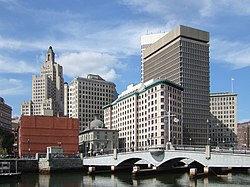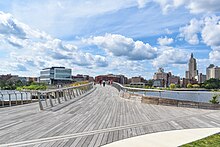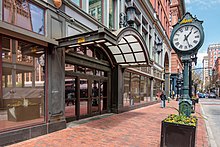
The Moshassuck River is a river in the U.S. state of Rhode Island. It flows 8.9 miles (14.3 km) from the town of Lincoln to the city of Providence. There are six dams along the river's length.

Thomas Alexander Tefft was an American architect, from Providence, Rhode Island. Tefft, one of the nation's first professionally trained architects, is considered a master of Rundbogenstil and a leading American proponent of its use. Prior to his untimely death, Tefft "offered the most advanced designs of [his] day in America"

The Woonasquatucket River, sometimes called "the Woony", is a river in the U.S. state of Rhode Island. It flows approximately 15.8 miles (25.4 km) and drains a watershed of 130 km2 (50 sq mi).

The Industrial Trust Building, located at 111 Westminster Street or 55 Kennedy Plaza in downtown Providence, Rhode Island, was built in 1928 as the Industrial Trust Co. Building, and was designed by the New York firm of Walker & Gillette. At 428 feet (130 m) with 26 floors, it is the tallest building in Providence and the state of Rhode Island, and the 28th tallest in New England; when it was completed it stood several stories higher than the recently finished Biltmore Hotel nearby.

The Westminster Arcade is an historic shopping center at 130 Westminster Street and 65 Weybosset Street in downtown Providence, Rhode Island erected in 1828. It is notable as the first enclosed shopping mall in the United States and has been lauded as a fine example of commercial Greek Revival architecture. It served as a shopping center for many years before falling into decline in the late 20th century. It has since been closed for renovation and rehabilitation several times, and most recently reopened its doors in October 2013 as a residential and commercial mixed-use building. It was declared a National Historic Landmark in 1976.

50 Kennedy Plaza is a postmodern skyscraper in Providence, Rhode Island. At a height of 285 ft (87 m), it is currently the sixth-tallest building in the city and state. The building is named for Kennedy Plaza, which stands to the structure's northeast.

The Rhode Island city of Providence has a nearly 400-year history integral to that of the United States, including significance in the American Revolutionary War by providing leadership and fighting strength, quartering troops, and supplying goods to residents by circumventing the blockade of Newport. The city is also noted for the first bloodshed of the American Revolution in the Gaspée Affair. Additionally, Providence is notable for economic shifts, moving from trading to manufacturing. The decline of manufacturing devastated the city during the Great Depression, but the city eventually attained economic recovery through investment of public funds.
AS220 is a non-profit community arts center located in Downtown, Providence, Rhode Island, United States. AS220 maintains four dozen artist live/work studios, around a dozen individual work studios, six rotating exhibition spaces, a main stage, a black box theater, a dance studio, a print shop, a community darkroom, a digital media lab, a fabrication lab, an organization-run bar and restaurant, a youth recording studio, and a youth program. AS220 is an unjuried and uncensored forum for the arts, open to all ages.

College Hill is a historic neighborhood of Providence, Rhode Island, and one of six neighborhoods comprising the city's East Side. It is roughly bounded by South and North Main Street to the west, Power Street to the south, Governor Street and Arlington Avenue to the east and Olney Street to the north. The neighborhood's primary commercial area extends along Thayer Street, a strip frequented by students in the Providence area.

Kennedy Plaza, formerly Exchange Place, Exchange Terrace, or City Hall Park, is a rectangular public square that occupies a central portion of Downtown Providence, Rhode Island. Since the mid 19th century, the plaza has served as a civic and transportation hub.
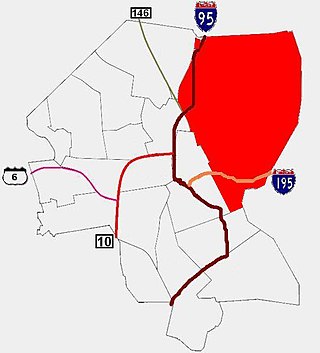
The East Side is a collection of neighborhoods in the eastern part of the city of Providence, Rhode Island. It officially comprises the neighborhoods of Blackstone, Hope, Mount Hope, College Hill, Wayland, and Fox Point.
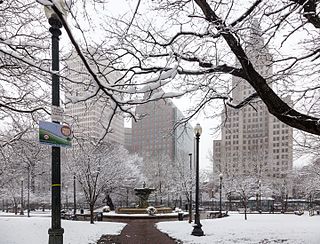
Burnside Park is a small park situated in Downtown Providence, Rhode Island, adjacent to Kennedy Plaza. The park is named for Ambrose Burnside, a general in the American Civil War from Rhode Island. An equestrian statue of Ambrose Burnside was erected in the late 19th century and sits in the center of the park.

The Blue Cross & Blue Shield of Rhode Island Headquarters is a LEED Certified high-rise in downtown Providence, Rhode Island.
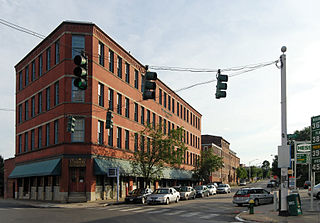
The Jewelry District is a neighborhood of Providence, Rhode Island located just southeast of Downtown. The historical path of Interstate 195 delineates the neighborhood's northern border while Interstate 95 and the Providence River define its western, southern and eastern edges.

Providence is the capital and most populous city of the U.S. state of Rhode Island. The county seat of Providence County, it is one of the oldest cities in New England, founded in 1636 by Roger Williams, a Reformed Baptist theologian and religious exile from the Massachusetts Bay Colony. He named the area in honor of "God's merciful Providence" which he believed was responsible for revealing such a haven for him and his followers. The city developed as a busy port, as it is situated at the mouth of the Providence River at the head of Narragansett Bay.

Alfred Stone was an American Architect. He was a founding partner of the Providence, Rhode Island, firm of Stone, Carpenter & Willson. Mr. Stone was best known for designing many prominent Rhode Island buildings, including the Providence Public Library, Union Station, buildings at Brown University and the University of Rhode Island, and many private homes.
The following is a timeline of the history of the city of Providence, Rhode Island, United States.

James C. Bucklin (1801-1890) was an American architect working in Providence, Rhode Island.
This is a list of protests in Rhode Island related to the murder of George Floyd.
